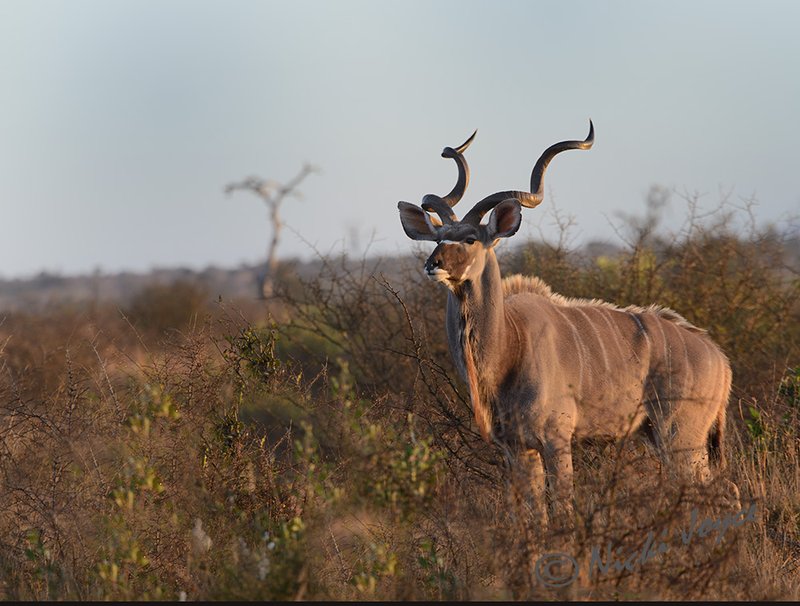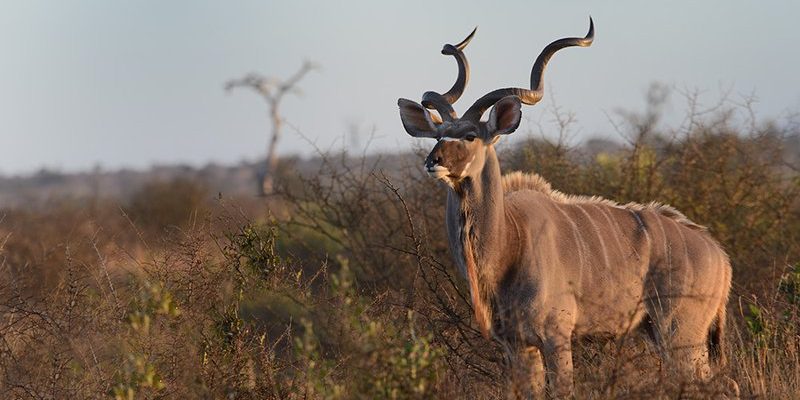
Kudus, with their striking features and gentle demeanor, thrive in certain areas of Africa. Picture wide open savannas and dense woodlands where they can roam freely. In today’s post, I’ll explain not only where kudus live but also why their habitat is essential for their survival and the overall health of their environment. So, let’s explore the world of kudus together and uncover the secrets of their habitats!
Understanding the Kudu Species
Let’s start with the basics. There are two main species of kudu: the greater kudu and the lesser kudu. Each species has its own preferred habitats and geographical distributions, which help shape their lifestyles and behaviors.
The greater kudu, with its impressive size and striking horns that can grow up to 72 inches, generally inhabits more open regions such as savannas and woodlands across eastern and southern Africa. This species is known for being quite shy, often blending into its surroundings to avoid predators. On the other hand, the lesser kudu is smaller and prefers more densely wooded areas, typically found in the bushy regions of eastern and southern Africa.
You might be wondering how these differences in size and habitat affect their behavior and social structure. In general, greater kudus are more social and often found in small herds, while lesser kudus are more solitary, preferring to keep their distance from large groups.
Kudu Habitat: What Does It Look Like?
Kudus thrive in environments that offer a mix of open spaces and dense cover. Think of it like having a cozy living room where you can relax and watch the world go by, but also having a few secret nooks for when you need some privacy.
The greater kudu prefers broad savannas and woodlands where acacia trees provide shade and leaves for grazing. These areas are often interspersed with shrubs and low plants, which offer both food and hiding spots from predators like lions and leopards. The lesser kudu, in contrast, enjoys more closed-in spaces like thickets and bushy areas. These spots are rich in foliage and provide excellent cover.
Both species rely heavily on their surroundings to thrive. For instance, kudus are browsers by nature, which means they mainly feed on leaves, shoots, and fruits. Having a variety of plants in their habitat plays a crucial role in their diet.
Distribution of Greater Kudus
When we talk about where greater kudus live, we’re mostly looking at a fascinating range of habitats. These antelopes are primarily found in eastern and southern Africa, with significant populations in countries like South Africa, Kenya, Tanzania, and Zimbabwe.
Greater kudus tend to inhabit areas close to water sources. These can be rivers, streams, or even waterholes in national parks. There’s a reason for this: water is crucial for their survival, especially in the hotter months when resources become scarce. Many nature reserves and national parks in these regions provide a protected environment for these kudus, allowing them to thrive without excessive human interference.
Interestingly, greater kudus are also known to migrate within their habitats, following seasonal changes and the availability of food and water. They have a keen sense of their environment, allowing them to adjust to shifts in their surroundings.
Distribution of Lesser Kudus
Now, let’s turn our attention to the lesser kudu, which has a more limited distribution compared to its greater counterpart. These antelopes primarily inhabit the bush and scrub areas of eastern Africa, found in countries like Ethiopia and parts of Kenya and Tanzania.
Unlike greater kudus, lesser kudus are often found in more densely wooded regions. They prefer thick bushland that provides ample cover, allowing them to evade predators. This preference for heavy cover is one reason why they don’t migrate as much as greater kudus. They stay within their smaller, defined territories where they feel safest.
Interestingly, lesser kudus are also more active at dawn and dusk, which is a behavior known as crepuscular. This means they tend to avoid the heat of the day and often come out to graze when it’s cooler.
Environmental Factors Affecting Kudu Habitats
The habitats of kudus are influenced by various environmental factors, and understanding these can give us valuable insights into their lives. Weather patterns, vegetation types, and human activities all play significant roles in shaping where kudus can live comfortably.
For starters, kudus thrive in habitats that offer both food and cover. Changes in climate, such as droughts or heavy rains, can affect plant growth and availability. If there’s a drought, vegetation can become sparse, forcing kudus to venture further in search of food and water. On the flip side, excessive rainfall can lead to flooding, impacting their ability to find shelter.
Human activities have a significant impact on kudu habitats as well. Urban development, agriculture, and poaching have all encroached upon their natural environments. Conservation efforts are crucial to protect these habitats and ensure that kudus can continue to thrive and contribute to the ecosystem.
The Importance of Kudu Habitats in Conservation
Kudu habitats are not just homes for these antelopes; they are also vital to the greater ecosystem. When you think about it, kudus play a crucial role in maintaining the balance of their environments.
By browsing on foliage and plants, they help control vegetation growth, which in turn supports the health of the ecosystem. Their grazing patterns encourage new plant growth, promoting biodiversity in their habitats. Plus, kudus are also prey for various predators, helping to sustain the food chain.
Conserving the habitats of kudus is essential not just for their survival but for the health of many other species as well. By protecting these areas, we safeguard the intricate web of life that exists within them. Conservation programs and efforts to manage their habitats can contribute immensely to preserving not only kudus but also the flora and fauna that coexist with them.
So, where do kudus live? They can be found in the savannas and woodlands of eastern and southern Africa, each species adapting beautifully to its surroundings. Understanding their habitat and distribution is key to appreciating the delicate balance of ecosystems they are part of.
As we’ve explored, kudus aren’t just fascinating creatures; they are integral components of their environments. Protecting their habitats doesn’t just benefit kudus. It also preserves the diverse ecosystems that rely on them. By fostering awareness and actively participating in conservation efforts, we can help ensure that these stunning antelopes continue to thrive for generations to come. Let’s work together to protect not only the kudus but the beautiful landscapes they call home!

